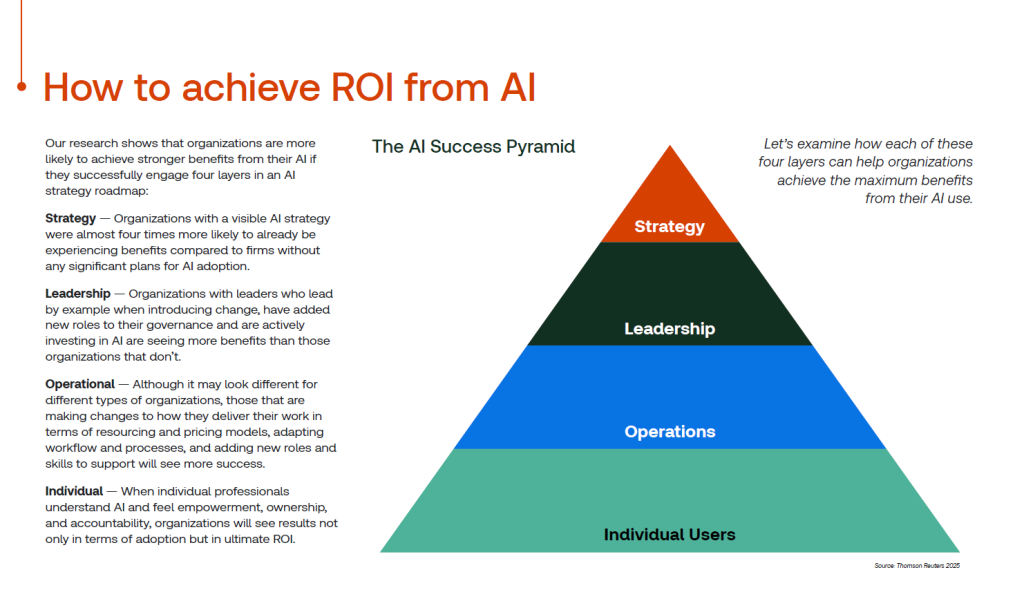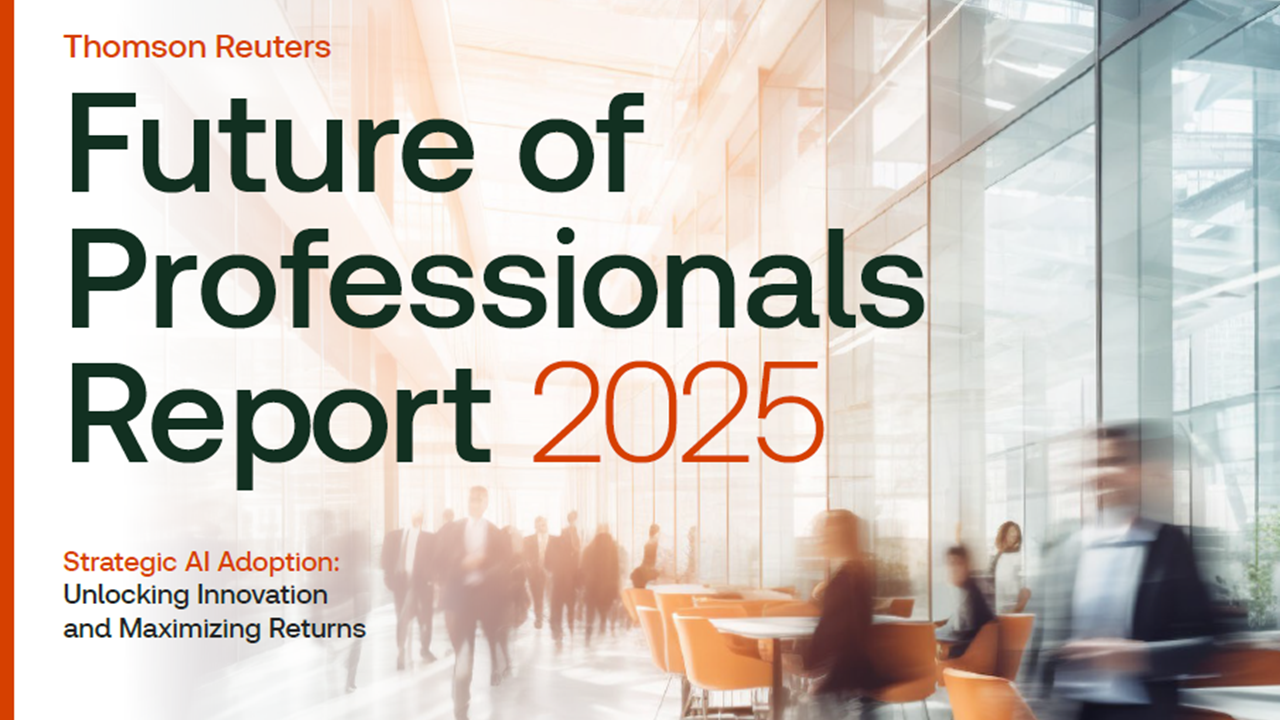A study out today from Thomson Reuters reveals a stark division within the legal profession: When it comes to reaping the benefits of AI, organizations with clear AI strategies are dramatically outperforming those without them, creating an increasingly pronounced competitive divide.
The 2025 Future of Professionals report, based on responses from 2,275 global professionals across legal, risk, compliance, tax, accounting, audit and trade industries, delivers some intriguing findings about the current state of AI adoption. Perhaps most striking is the performance gap between strategic and ad-hoc AI adopters.
Organizations with visible AI strategies are twice as likely to experience revenue growth as a direct or indirect result of AI adoption compared to those taking more informal approaches. Even more dramatically, they are 3.5 times more likely to experience critical AI benefits when compared to organizations with no significant AI adoption plans at all.
Even so, however, only 22% of organizations report having a visible, defined AI strategy. This means that nearly four out of five organizations may be missing out on the substantial advantages that come from strategically integrating AI into their operations.
AI Success Pyramid
In describing why strategic approaches to AI adoption are more effective, Thomson Reuters identifies the “AI Success Pyramid” – a four-layer framework that distinguishes high-performing AI adopters from the rest.
 The foundation layer focuses on individual users who understand AI capabilities and feel empowered to use these tools effectively. The research shows that professionals with good or expert AI knowledge are 2.8 times more likely to see organizational benefits compared to those with basic understanding.
The foundation layer focuses on individual users who understand AI capabilities and feel empowered to use these tools effectively. The research shows that professionals with good or expert AI knowledge are 2.8 times more likely to see organizational benefits compared to those with basic understanding.
The second layer emphasizes operational changes – how organizations adapt their workflows, processes, and service delivery models to maximize AI’s potential. About one-third of firms have experienced changes to their team workflows in the past year, with another quarter anticipating changes soon.
The third layer centers on leadership that actively invests in AI technology and leads by example during periods of change. Organizations whose leaders consistently demonstrate new behaviors during transitions are 1.7 times more likely to see AI benefits.
At the top sits strategy – the comprehensive planning that ties AI initiatives to broader organizational goals. This strategic layer proves to be the strongest predictor of success, with strategically-focused organizations showing dramatically better outcomes across all measured dimensions.
‘Implementation Reality Gap’
One of the most revealing aspects of the study is what researchers call the “implementation reality gap.” While 80% of law firm professionals believe AI will transform or have high impact on their work, only 29% expect high levels of change at their firm this year.
As Raghu Ramanathan, president of Legal Professionals at Thomson Reuters, said of the findings: “While 80% of law firm professionals believe AI will transform or have a high impact on their work, only 29% expect high levels of change at their firm this year. This disconnect sends a clear message: access to the latest technology does not automatically mean value creation for law firms.
“In this era of transformation, having enthusiasm for AI is not enough. Lawyers now understand that AI adoption is harder than initially anticipated and law firms have struggled to fundamentally re-engineer their processes and workflows to incorporate AI.”
This gap illustrates a crucial point about AI adoption in legal settings, the study suggests. Having access to AI tools doesn’t automatically translate to meaningful organizational change or competitive advantage. The difference lies in how systematically and strategically firms approach implementation.
Economics of AI Efficiency
The financial implications of effective AI adoption are considerable, the report finds. Survey respondents predict that professionals using AI will save five hours weekly within the next year, up from four hours predicted in 2024. This represents an average annual value of $19,000 per professional.
For the United States alone, this AI-driven efficiency could translate to a $32 billion combined annual impact for the legal and tax industries. This figure represents not just cost savings, but the economic value of redirecting professional time toward higher-value activities.
However, realizing these benefits requires more than simply deploying AI tools, the study says. Organizations need strategic frameworks to capture and reinvest the productivity gains that AI enables.
Unique Challenges for Legal
Due to their high standards for accuracy and reliability, legal professionals face unique challenges for AI adoption, the study finds. The study reveals that 91% of law firm professionals believe computers should be held to higher accuracy standards than humans, with 41% requiring 100% accuracy before AI outputs could be used without human review.
This finding highlights why legal AI products must be built differently than consumer applications, Ramanathan says. “The challenge to adopt AI isn’t just technological – it’s about meeting the exceptionally high standards legal professionals demand. With 91% of law firm professionals believing computers should be held to higher accuracy standards than humans, professional-grade AI solutions must be built on domain expertise and trusted data with key integrations and a human-in-the-loop, while delivering measurable ROI.”
The Jagged Edge of Adoption
Another interesting finding of the report is what it calls the “jagged edge” of AI adoption – the uneven and sometimes contradictory patterns of implementation across and within organizations.
The study finds significant disparities in adoption approaches, even within the same organization. Some departments or practice groups may be early AI adopters while others lag significantly behind. This creates both risks and opportunities.
The risk comes when individual professionals use public AI tools without organizational safeguards, potentially exposing sensitive client information or creating liability issues. Conversely, high organizational investment paired with low individual usage suggests poor change management and potentially wasted resources.
The opportunity lies in recognizing that different functions within a legal organization may legitimately require different AI adoption timelines. Areas with standardized, repeatable tasks can benefit from rapid AI integration, while those requiring nuanced judgment may need more measured approaches.
Evolving Professional Roles
Another issue the study examines is how professional roles are evolving due to AI. The research reveals that 55% of professionals have experienced significant changes in their day-to-day work over the past year or expect to within the next twelve months.
The emerging “modern professional” maintains all traditional core competencies – technical domain expertise, practical abilities like research and writing, interpersonal effectiveness, higher-order thinking, and organizational skills – but augments these capabilities with AI tools, the study says.
For example, a modern legal professional might use AI to analyze case law patterns and predict judicial outcomes, employ AI tools to compare complex regulations across multiple jurisdictions, or leverage AI to draft preliminary documents based on specific parameters while maintaining full oversight and final responsibility for the work product.
Importantly, 88% of professionals favor having profession-specific AI assistants, though opinions differ on whether this will become a competitive requirement or a differentiating advantage.
At the same time, the study identifies notable skills gaps within legal teams, with 46% of professionals reporting gaps in their organizations. Most significantly, 31% report gaps in technology and data skills, while 10% identify deficiencies in technical domain expertise.
Generational differences play a role here. Gen Z professionals are twice as likely as Baby Boomers to identify insufficient digital literacy among colleagues. However, the research also reveals that Gen X professionals demonstrate stronger technological engagement than commonly assumed, participating in AI training at rates exceeding their younger colleagues.
Competitive Implications
The study’s findings suggest that the legal industry may be approaching a tipping point. Organizations that develop and execute coherent AI strategies position themselves to capture significant competitive advantages in efficiency, service delivery, and cost structure.
Conversely, the nearly one-third of organizations without significant AI adoption plans risk falling behind as competitors transform their operations and service capabilities. As Thomson Reuters CEO Steve Hasker puts it: “Organizations with clear, aligned strategies are unlocking real ROI: reclaiming time, cutting costs, and gaining ground. Professionals who are embracing AI are not just more productive — they’re staying relevant.”
This creates what Ramanathan describes as a critical urgency: “There is a stark competitive divide amongst law firms when it comes to AI, and those without a plan for AI adoption, which is nearly one-third, put themselves at risk of falling behind as competitors transform their operations. … This isn’t a topic for your partner retreat in six months — this transformation is happening now.”
The Bottom Line
The study ultimately points toward a future where AI becomes deeply integrated into legal practice, but with a major advantage for organizations that approach adoption strategically and systematically. Success requires more than acquiring AI tools, the study suggests, it demands thoughtful integration of technology with professional expertise, organizational processes, and client service delivery.
The study is further evidence that, for legal professionals, the question is no longer whether to adopt AI technologies, but rather how quickly and effectively organizations can integrate them while maintaining their high professional standards. Those who master this balance will likely have the competitive upper hand.
 Robert Ambrogi Blog
Robert Ambrogi Blog
